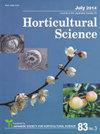桔梗花同源MADS-box基因的保存与多样性研究
Journal of The Japanese Society for Horticultural Science
Pub Date : 2014-04-01
DOI:10.2503/JJSHS1.CH-098
引用次数: 6
摘要
MADS-box基因家族是植物中最大的转录因子基因家族之一,在植物发育的各个阶段都是必需的。许多关于花发育的研究表明,特别是mikcc型MADSbox基因对花器官的正常发育至关重要。我们鉴定并鉴定了桔梗花中表达的mikcc型MADS-box基因。鉴定出23个基因,并将其分为10个分支,这些分支具有保守的特定基序。系统发育分析表明,AG/PLE、AP3/DEF、PI/GLO和SEP进化支具有多样性,近期发生了基因重复事件。花器官特异性表达模式在AP3/DEF和SEP分支的基因成员中部分多样化,而在AG/PLE和PI/GLO分支中则较为保守。这些结果表明,保守表达基因和多样化表达基因都参与了桔梗花器官身份的确定。本文章由计算机程序翻译,如有差异,请以英文原文为准。
Conservation and Diversification of Floral Homeotic MADS-box Genes in Eustoma grandiflorum
The MADS-box gene family is one of the largest transcription factor gene families in plants and is necessary at various developmental stages. Many studies on flower development show that especially MIKCc-type MADSbox genes are essential for proper floral organ development. We identified and characterized MIKCc-type MADS-box genes expressed in Eustoma grandiflorum flowers. Twenty-three genes were identified and grouped into 10 clades, which were characterized by conserved specific motifs. Phylogenetic analysis indicated the diversification of AG/PLE, AP3/DEF, PI/GLO, and SEP clades and the occurrence of recent gene duplication events. The floral organ-specific expression patterns were partly diversified within the gene members of AP3/DEF and SEP clades, while they were conserved in AG/PLE and PI/GLO clades. These results suggest that genes with conserved expression as well as those with diversified expression contribute to specifying floral organ identity in E. grandiflorum.
求助全文
通过发布文献求助,成功后即可免费获取论文全文。
去求助
来源期刊
自引率
0.00%
发文量
0
审稿时长
>36 weeks

 求助内容:
求助内容: 应助结果提醒方式:
应助结果提醒方式:


